Abstract
Plasma 1-norepinephrine and epinephrine contents were strikingly elevated in 70 patients during evolution of myocardial infarction. Propranolol or placebo, 0.1 mg/kg i.v., was administered randomly an average of 10 h after infarction and continued orally for 3 d. Propranolol, but not placebo, acutely decreased 1-norepinephrine contents from 2.24 +/- 1.33 (mean +/- SD) to 1.31 +/- 0.74 microgram/liter, P less than 0.001, and epinephrine contents from 0.97 +/- 0.42 to 0.74 +/- 0.42 microgram/liter, P less than 0.02. Decreases in 1-norepinephrine contents were related to the initial plasma concentrations, r = 0.85, P less than 0.001. A similar, but less strong relationship was observed between the initial epinephrine contents and propranolol-induced changes, r = -0.51, P less than 0.01. Propranolol reduced plasma-free fatty acid contents from 1,121 +/- 315 to 943 +/- 274 mumol/liter, P less than 0.001. Decreases in plasma contents of free fatty acids were related to decreases in epinephrine, r = 0.66, P less than 0.001. Propranolol did not cause significant additional changes in plasma catecholamine contents during the subsequent 3 d. In the placebo group 1-norepinephrine contents had decreased 24 h after infarction from 1.92 +/- 0.99 to 1.37 +/- 0.93 microgram/liter, P less than 0.02. Plasma epinephrine contents did not change. Heart rate remained below the control values during the entire study period in the propranolol, but increased in the placebo group. The data indicate that sympathetic hyperactivity, indirectly reflected by plasma catecholamine contents, is acutely reduced by propranolol during evolution of myocardial infarction.
Full text
PDF
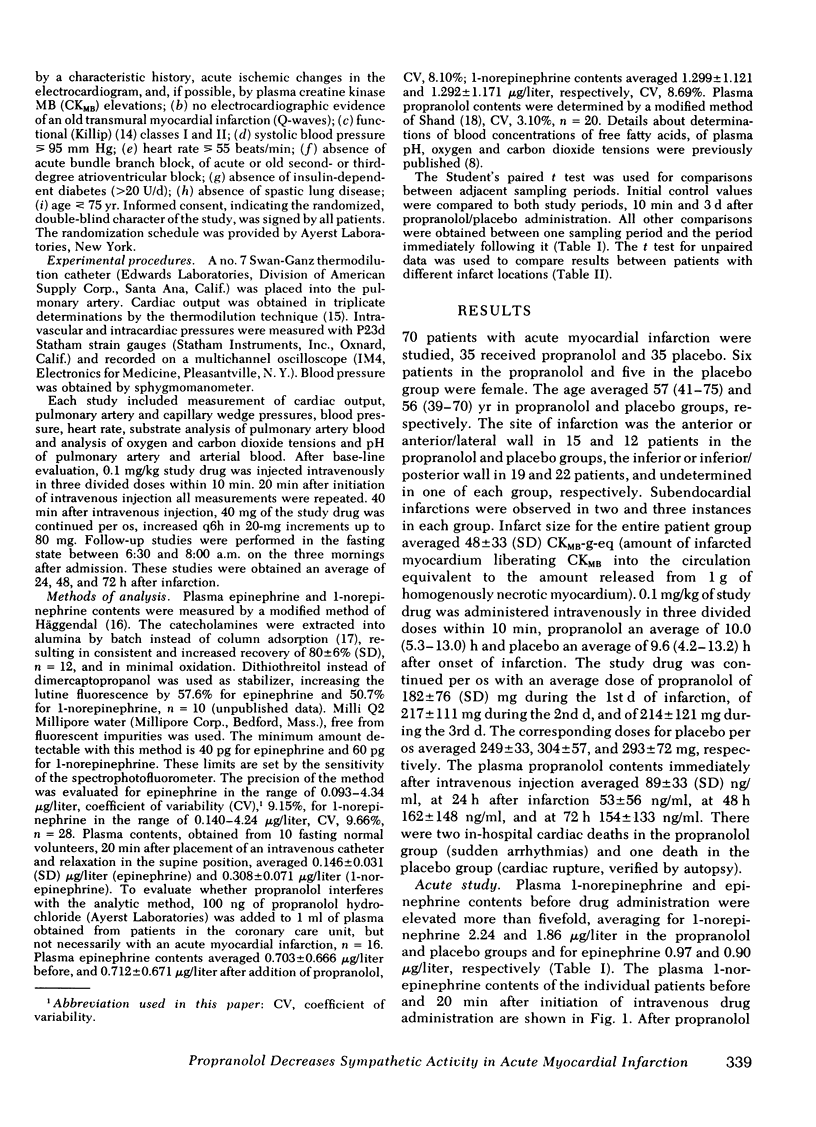
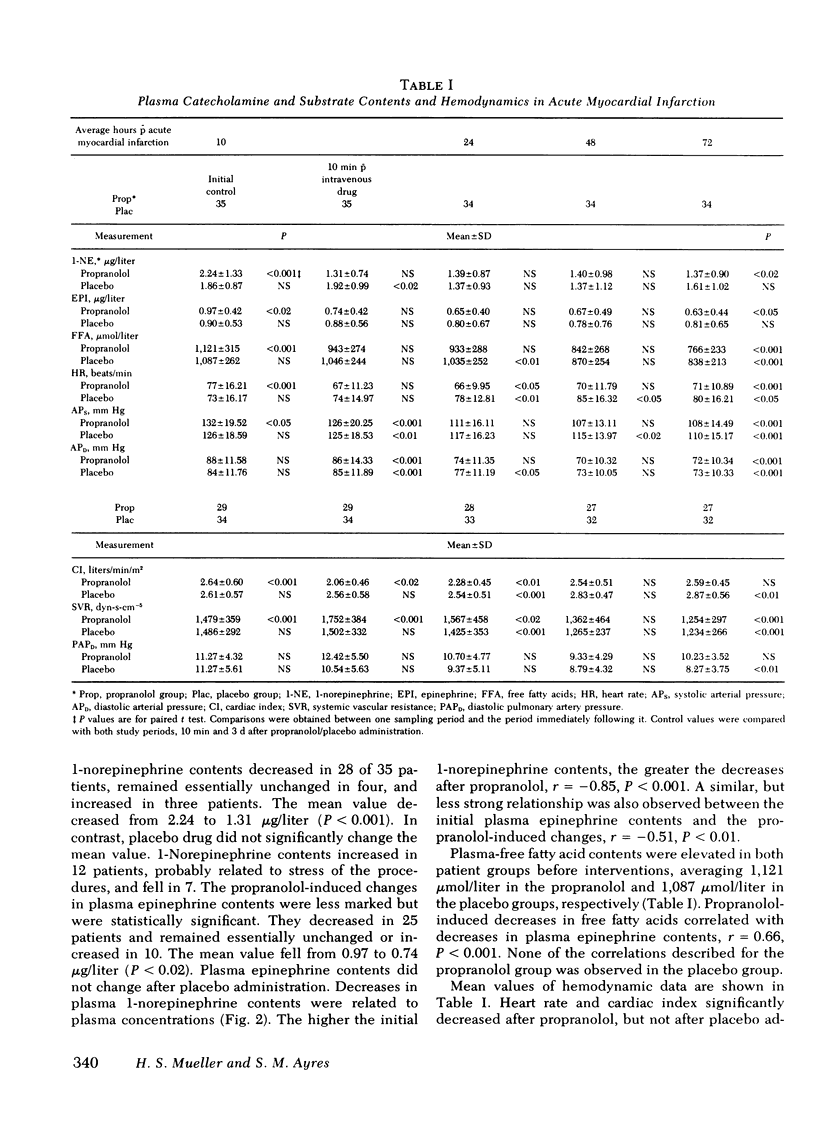
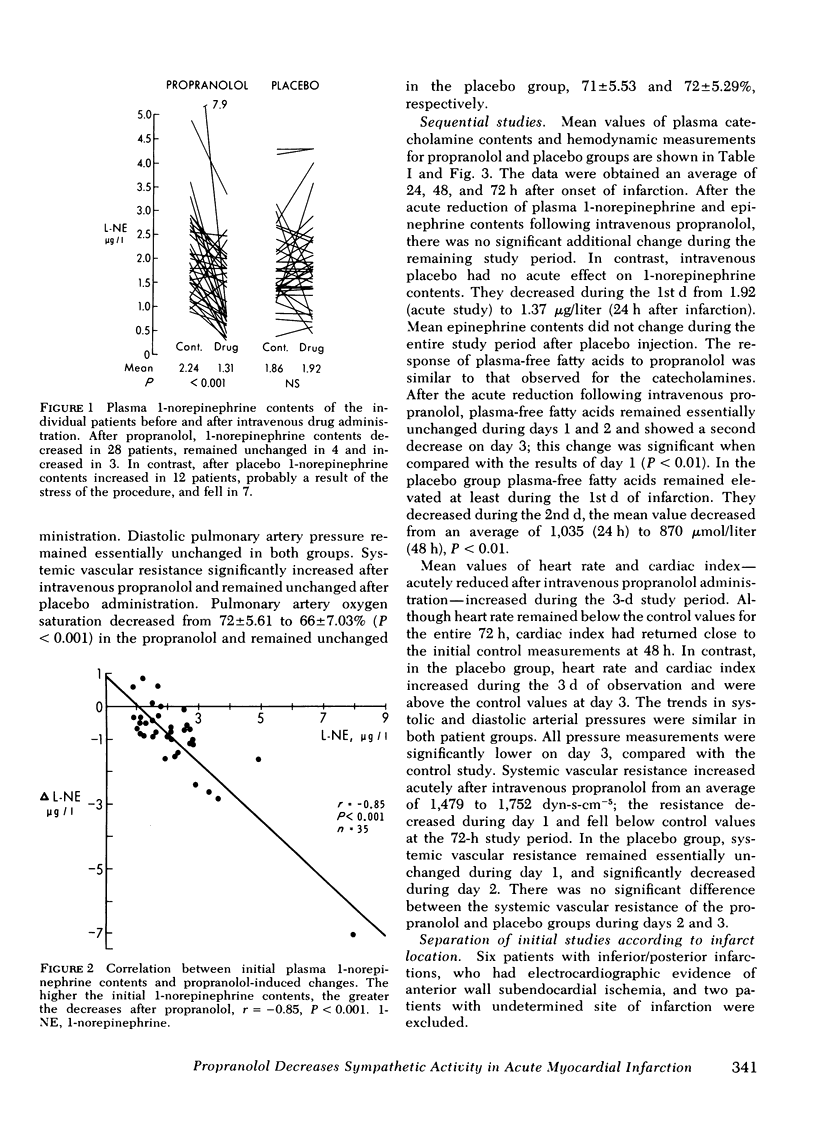
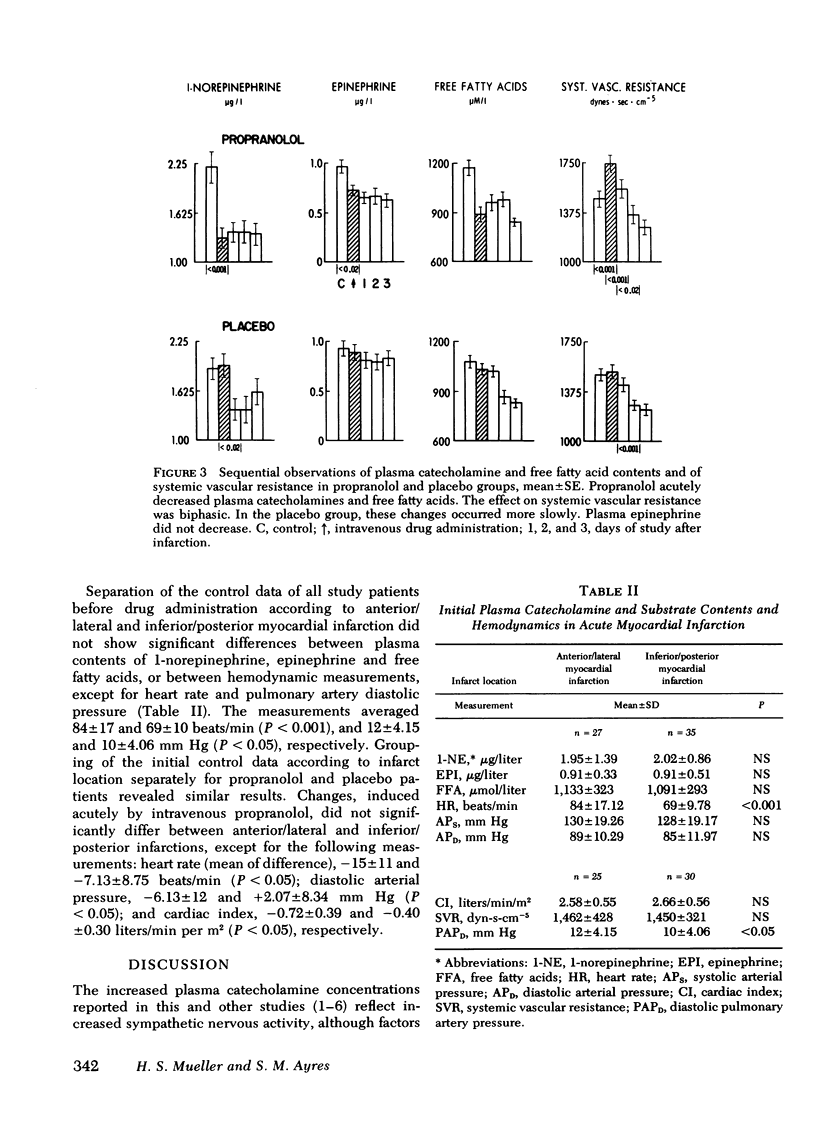
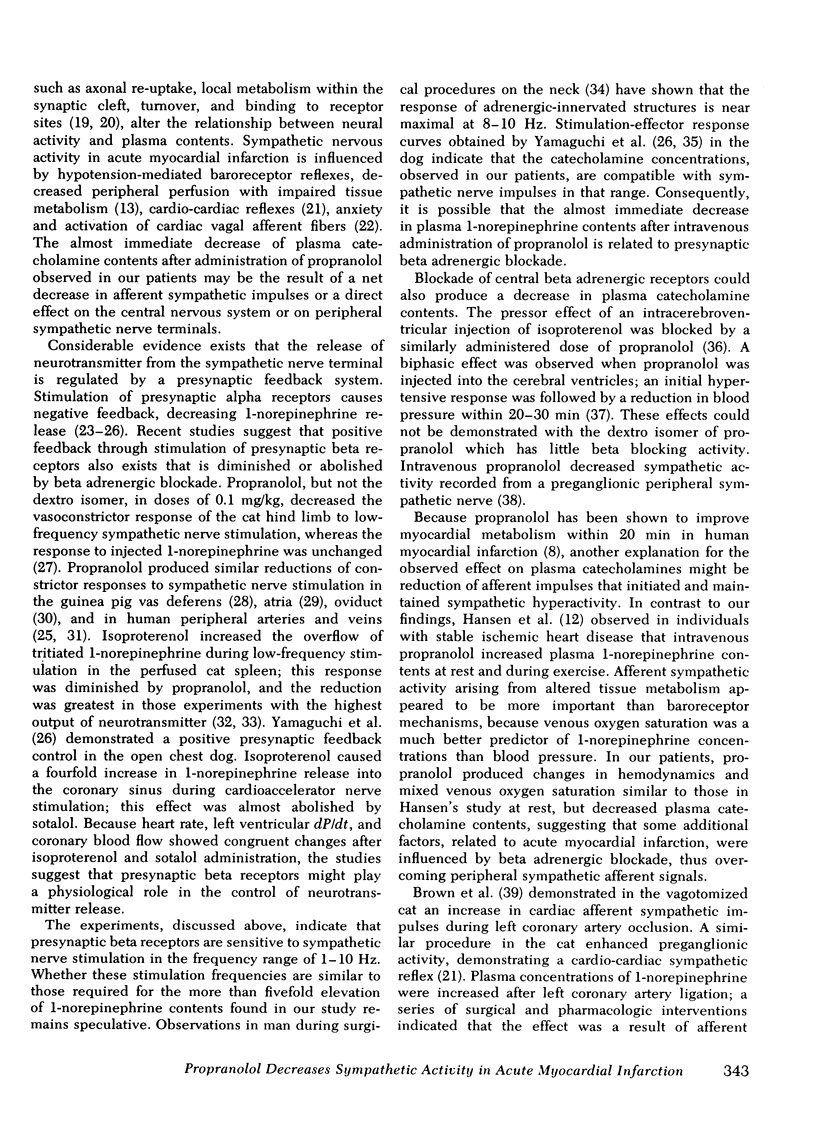
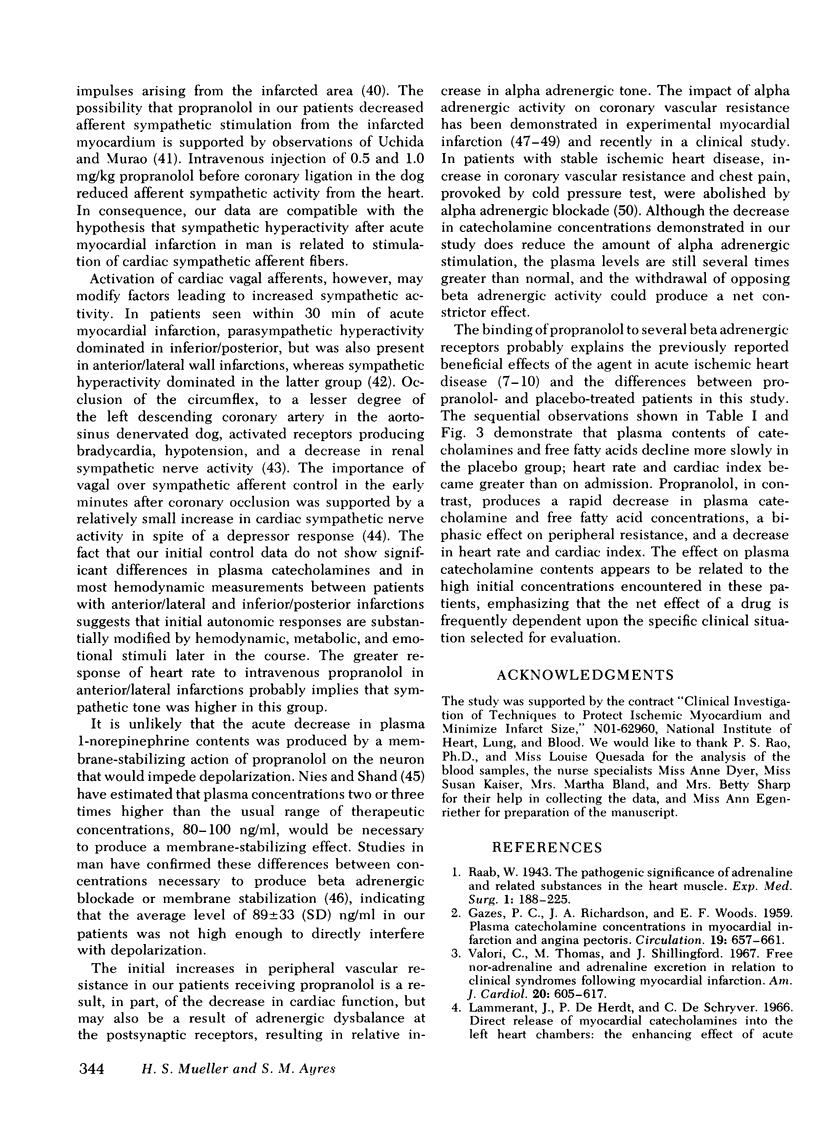

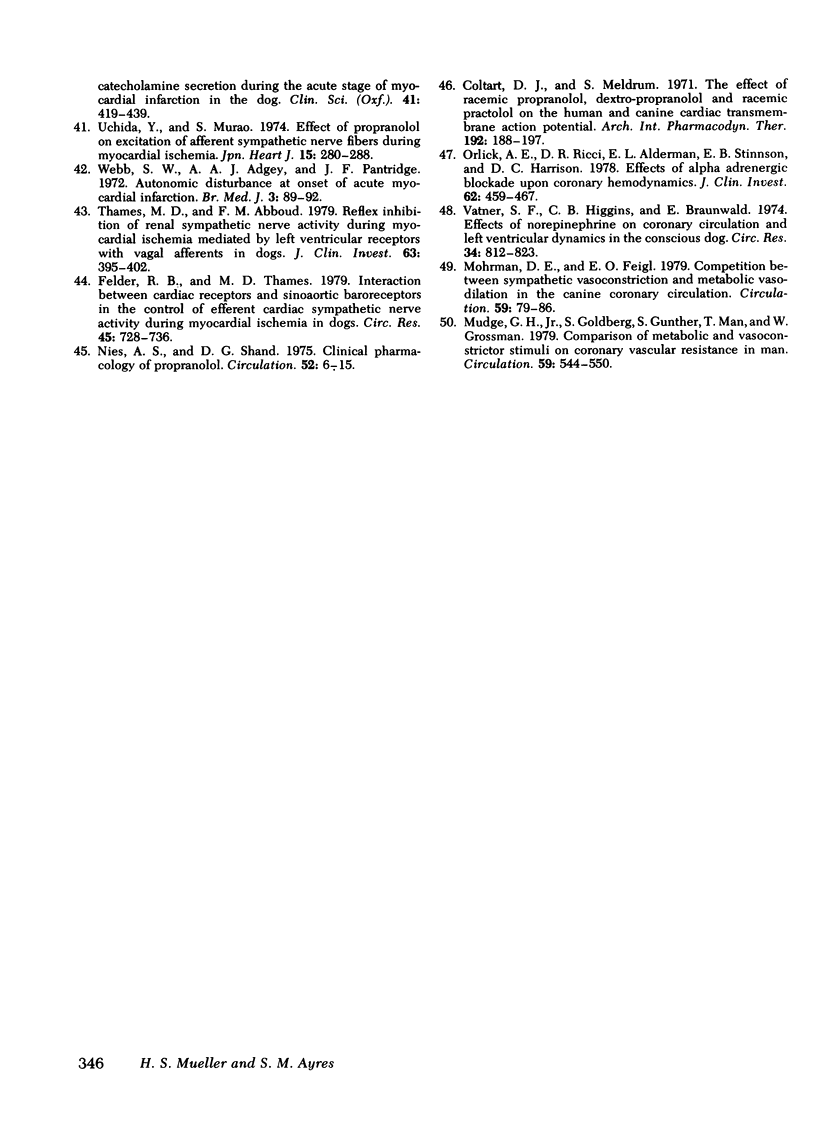
Selected References
These references are in PubMed. This may not be the complete list of references from this article.
- Ablad B., Ek L., Johansson B., Waldeck B. Inhibitory effect of propranolol on the vasoconstrictor response to sympathetic nerve stimulation. J Pharm Pharmacol. 1970 Aug;22(8):627–628. doi: 10.1111/j.2042-7158.1970.tb10585.x. [DOI] [PubMed] [Google Scholar]
- Adler-Graschinsky E., Langer S. Z. Possible role of a beta-adrenoceptor in the regulation of noradrenaline release by nerve stimulation through a positive feed-back mechanism. Br J Pharmacol. 1975 Jan;53(1):43–50. doi: 10.1111/j.1476-5381.1975.tb07328.x. [DOI] [PMC free article] [PubMed] [Google Scholar]
- Brown A. M. Excitation of afferent cardiac sympathetic nerve fibres during myocardial ischaemia. J Physiol. 1967 May;190(1):35–53. doi: 10.1113/jphysiol.1967.sp008191. [DOI] [PMC free article] [PubMed] [Google Scholar]
- CHANG C. C. A SENSITIVE METHOD FOR SPECTROPHOTOFLUOROMETRIC ASSAY OF CATECHOLAMINES. Int J Neuropharmacol. 1964 Dec;3:643–649. doi: 10.1016/0028-3908(64)90089-9. [DOI] [PubMed] [Google Scholar]
- Celuch S. M., Dubocovich M. L., Lander S. Z. Stimulation of presynaptic beta-adrenoceptors enhances [3H]-noradrenaline release druing nerve stimulation in the perfused cat spleen. Br J Pharmacol. 1978 May;63(1):97–109. doi: 10.1111/j.1476-5381.1978.tb07779.x. [DOI] [PMC free article] [PubMed] [Google Scholar]
- Christensen N. J. Plasma catecholamines and arterial hypertension. Acta Med Scand Suppl. 1976;602:57–60. doi: 10.1111/j.0954-6820.1977.tb07646.x. [DOI] [PubMed] [Google Scholar]
- Coltart D. J., Meldrum S. J. The effect of racemic propranolol, dextro-propranolol and racemic practolol on the human and canine cardiac transmembrane action potential (beta blockade and the cardiac action potential). Arch Int Pharmacodyn Ther. 1971 Jul;192(1):188–197. [PubMed] [Google Scholar]
- Day M. D., Roach A. G. Cardiovascular effects of beta-adrenoreceptor blocking agents after intracerebroventricular administration in conscious normotensive cats. Clin Exp Pharmacol Physiol. 1974 Jul-Aug;1(4):333–339. doi: 10.1111/j.1440-1681.1974.tb00555.x. [DOI] [PubMed] [Google Scholar]
- FOLKOW B., HAMBERGER C. A. Characteristics of sympathetic neuroeffectors in man. J Appl Physiol. 1956 Sep;9(2):268–270. doi: 10.1152/jappl.1956.9.2.268. [DOI] [PubMed] [Google Scholar]
- Felder R. B., Thames M. D. Interaction between cardiac receptors and sinoaortic baroreceptors in the control of efferent cardiac sympathetic nerve activity during myocardial ischemia in dogs. Circ Res. 1979 Dec;45(6):728–736. doi: 10.1161/01.res.45.6.728. [DOI] [PubMed] [Google Scholar]
- GAZES P. C., RICHARDSON J. A., WOODS E. F. Plasma catechol amine concentrations in myocardial infarction and angina pectoris. Circulation. 1959 May;19(5):657–661. doi: 10.1161/01.cir.19.5.657. [DOI] [PubMed] [Google Scholar]
- Ganz W., Donoso R., Marcus H. S., Forrester J. S., Swan H. J. A new technique for measurement of cardiac output by thermodilution in man. Am J Cardiol. 1971 Apr;27(4):392–396. doi: 10.1016/0002-9149(71)90436-x. [DOI] [PubMed] [Google Scholar]
- Gold H. K., Leinbach R. C., Maroko P. R. Propranolol-induced reduction of signs of ischemic injury during acute myocardial infarction. Am J Cardiol. 1976 Nov 23;38(6):689–695. doi: 10.1016/0002-9149(76)90344-1. [DOI] [PubMed] [Google Scholar]
- HAEGGENDAL J. AN IMPROVED METHOD FOR FLUORIMETRIC DETERMINATION OF SMALL AMOUNTS OF ADRENALINE AND NORADRENALINE IN PLASMA AND TISSUES. Acta Physiol Scand. 1963 Nov;59:242–254. doi: 10.1111/j.1748-1716.1963.tb02739.x. [DOI] [PubMed] [Google Scholar]
- Hansen J. F., Hesse B., Christensen N. J. Enhanced sympathetic nervous activity after intravenous propranolol in ischaemic heart disease: plasma noradrenaline splanchnic blood flow and mixed venous oxygen saturation at rest and during exercise. Eur J Clin Invest. 1978 Feb;8(1):31–36. doi: 10.1111/j.1365-2362.1978.tb00805.x. [DOI] [PubMed] [Google Scholar]
- Hedqvist P., Moawad A. Presynaptic alpha- and beta-adrenoceptor medicated control of noradrenaline release in human oviduct. Acta Physiol Scand. 1975 Dec;95(4):494–496. doi: 10.1111/j.1748-1716.1975.tb10079.x. [DOI] [PubMed] [Google Scholar]
- Irving M. H., Britton B. J., Wood W. G., Padgham C., Carruthers M. Effects of beta adrenergic blockade on plasma catecholamines in exercise. Nature. 1974 Apr 5;248(448):531–533. doi: 10.1038/248531a0. [DOI] [PubMed] [Google Scholar]
- Kopin I. J., Lake R. C., Ziegler M. Plasma levels of norepinephrine. Ann Intern Med. 1978 May;88(5):671–680. doi: 10.7326/0003-4819-88-5-671. [DOI] [PubMed] [Google Scholar]
- Lammerant J., De Herdt P., De Schryver C. Direct release of myocardial catecholamines into the left heart chambers : the enhancing effect of acute coronary occlusion. Arch Int Pharmacodyn Ther. 1966 Sep;163(1):219–226. [PubMed] [Google Scholar]
- Langer S. Z. The metabolism of (3H)noradrenaline released by electrical stimulation from the isolated nictitating membrane of the cat and from the vas deferens of the rat. J Physiol. 1970 Jul;208(3):515–546. doi: 10.1113/jphysiol.1970.sp009135. [DOI] [PMC free article] [PubMed] [Google Scholar]
- Langer S. Z. The role of alpha- and beta-presynaptic receptors in the regulation of noradrenaline release elicited by nerve stimulation. Clin Sci Mol Med Suppl. 1976 Dec;3:423s–426s. doi: 10.1042/cs051423s. [DOI] [PubMed] [Google Scholar]
- Lewis P. J., Haeusler G. Reduction in sympathetic nervous activity as a mechanism for hypotensive effect of propranolol. Nature. 1975 Jul 31;256(5516):440–440. doi: 10.1038/256440a0. [DOI] [PubMed] [Google Scholar]
- Malliani A., Schwartz P. J., Zanchetti A. A sympathetic reflex elicited by experimental coronary occlusion. Am J Physiol. 1969 Sep;217(3):703–709. doi: 10.1152/ajplegacy.1969.217.3.703. [DOI] [PubMed] [Google Scholar]
- Mudge G. H., Jr, Goldberg S., Gunther S., Mann T., Grossman W. Comparison of metabolic and vasoconstrictor stimuli on coronary vascular resistance in man. Circulation. 1979 Mar;59(3):544–550. doi: 10.1161/01.cir.59.3.544. [DOI] [PubMed] [Google Scholar]
- Mueller H. S., Ayres S. M., Religa A., Evans R. G. Propranolol in the treatment of acute myocardial infarction. Effect on myocardial oxygenation and hemodynamics. Circulation. 1974 Jun;49(6):1078–1087. doi: 10.1161/01.cir.49.6.1078. [DOI] [PubMed] [Google Scholar]
- Mylecharane E. J., Raper C. Prejunctional actions of some beta-adrenoreceptor antagonists in the vas deferens preparation of the guinea-pig. Br J Pharmacol. 1970 May;39(1):128–138. doi: 10.1111/j.1476-5381.1970.tb09562.x. [DOI] [PMC free article] [PubMed] [Google Scholar]
- Nies A. S., Shand D. G. Clinical pharmacology of propranolol. Circulation. 1975 Jul;52(1):6–15. doi: 10.1161/01.cir.52.1.6. [DOI] [PubMed] [Google Scholar]
- Orlick A. E., Ricci D. R., Alderman E. L., Stinson E. B., Harrison D. C. Effects of alpha adrenergic blockade upon coronary hemodynamics. J Clin Invest. 1978 Aug;62(2):459–467. doi: 10.1172/JCI109147. [DOI] [PMC free article] [PubMed] [Google Scholar]
- Peter T., Norris R. M., Clarke E. D., Heng M. K., Singh B. N., Williams B., Howell D. R., Ambler P. K. Reduction of enzyme levels by propranolol after acute myocardial infarction. Circulation. 1978 Jun;57(6):1091–1095. doi: 10.1161/01.cir.57.6.1091. [DOI] [PubMed] [Google Scholar]
- Reid J. L., Lewis P. J., Myers M. G., Dollery C. T. Cardiovascular effects of intracerebroventricular d-, l- and dl-propranolol in the conscious rabbit. J Pharmacol Exp Ther. 1974 Feb;188(2):394–399. [PubMed] [Google Scholar]
- Shand D. G., Nuckolls E. M., Oates J. A. Plasma propranolol levels in adults with observations in four children. Clin Pharmacol Ther. 1970 Jan-Feb;11(1):112–120. doi: 10.1002/cpt1970111112. [DOI] [PubMed] [Google Scholar]
- Siggers D. C., Salter C., Fluck D. C. Serial plasma adrenaline and noradrenaline levels in myocardial infarction using a new double isotope technique. Br Heart J. 1971 Nov;33(6):878–883. doi: 10.1136/hrt.33.6.878. [DOI] [PMC free article] [PubMed] [Google Scholar]
- Silverberg A. B., Shah S. D., Haymond M. W., Cryer P. E. Norepinephrine: hormone and neurotransmitter in man. Am J Physiol. 1978 Mar;234(3):E252–E256. doi: 10.1152/ajpendo.1978.234.3.E252. [DOI] [PubMed] [Google Scholar]
- Starke K. Influence of extracellular noradrenaline on the stimulation-evoked secretion of noradrenaline from sympathetic nerves: evidence for an -receptor-mediated feed-back inhibition of noradrenaline release. Naunyn Schmiedebergs Arch Pharmacol. 1972;275(1):11–23. doi: 10.1007/BF00505064. [DOI] [PubMed] [Google Scholar]
- Stj-5aarne L., Brundin J. Dual adreoceptor-mediated control of noradrenaline secretion from human vasoconstrictor nerves: facilitation by BETA-receptors and inhibitor by alpha-receptors. Acta Physiol Scand. 1975 May;94(1):139–141. doi: 10.1111/j.1748-1716.1975.tb05872.x. [DOI] [PubMed] [Google Scholar]
- Stjärne L., Brundin J. Beta2-adrenoceptors facilitating noradrenaline secretion from human vasoconstrictor nerves. Acta Physiol Scand. 1976 Mar;97(1):88–93. doi: 10.1111/j.1748-1716.1976.tb10238.x. [DOI] [PubMed] [Google Scholar]
- Thames M. D., Abboud F. M. Reflex inhibition of renal sympathetic nerve activity during myocardial ischemia mediated by left ventricular receptors with vagal afferents in dogs. J Clin Invest. 1979 Mar;63(3):395–402. doi: 10.1172/JCI109315. [DOI] [PMC free article] [PubMed] [Google Scholar]
- Uchida Y., Murao S. Effect of propranolol on excitation of afferent sympathetic nerve fibers during myocardial ischemia. Jpn Heart J. 1974 May;15(3):280–288. doi: 10.1536/ihj.15.280. [DOI] [PubMed] [Google Scholar]
- Valori C., Thomas M., Shillingford J. Free noradrenaline and adrenaline excretion in relation to clinical syndromes following myocardial infarction. Am J Cardiol. 1967 Nov;20(5):605–617. doi: 10.1016/0002-9149(67)90001-x. [DOI] [PubMed] [Google Scholar]
- Vatner S. F., Baig H., Manders W. T., Ochs H., Pagani M. Effects of propranolol on regional myocardial function, electrograms, and blood flow in conscious dogs with myocardial ischemia. J Clin Invest. 1977 Aug;60(2):353–360. doi: 10.1172/JCI108783. [DOI] [PMC free article] [PubMed] [Google Scholar]
- Vatner S. F., Higgins C. B., Braunwald E. Effects of norepinephrine on coronary circulation and left ventricular dynamics in the conscious dog. Circ Res. 1974 Jun;34(6):812–823. doi: 10.1161/01.res.34.6.812. [DOI] [PubMed] [Google Scholar]
- Videbaek J., Christensen N. J., Sterndorff B. Serial determination of plasma catecholamines in myocardial infarction. Circulation. 1972 Nov;46(5):846–855. doi: 10.1161/01.cir.46.5.846. [DOI] [PubMed] [Google Scholar]
- Webb S. W., Adgey A. A., Pantridge J. F. Autonomic disturbance at onset of acute myocardial infarction. Br Med J. 1972 Jul 8;3(5818):89–92. doi: 10.1136/bmj.3.5818.89. [DOI] [PMC free article] [PubMed] [Google Scholar]
- Wolk M. J., Scheidt S., Killip T. Heart failure complicating acute myocardial infarction. Circulation. 1972 May;45(5):1125–1138. doi: 10.1161/01.cir.45.5.1125. [DOI] [PubMed] [Google Scholar]
- Yamaguchi N., de Champlain J., Nadeau R. A. Regulation of norepinephrine release from cardiac sympathetic fibers in the dog by presynaptic alpha- and beta-receptors. Circ Res. 1977 Jul;41(1):108–117. doi: 10.1161/01.res.41.1.108. [DOI] [PubMed] [Google Scholar]
- Yamaguchi N., de Champlain J., Nadeau R. Correlation between the response of the heart to sympathetic stimulation and the release of endogenous catecholamines into the coronary sinus of the dog. Circ Res. 1975 May;36(5):662–668. doi: 10.1161/01.res.36.5.662. [DOI] [PubMed] [Google Scholar]


